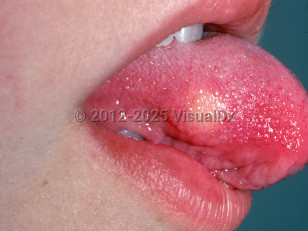Granular cell tumors are more common in females and individuals of African descent. The average reported age is between the fourth and fifth decades. Benign granular cell tumors are usually slow growing. Malignant granular cell tumors represent fewer than 2% of cases. They can have rapid growth and possess metastatic potential. The most common sites for metastasis are regional lymph nodes, lungs, and bones. Patients with malignant granular cell tumor are at risk for development of pancreatic and renal cell cancers.
Granular cell tumors are typically solitary, although the presence of more than one tumor has been reported. Nodules occur most frequently intraorally, especially on the tongue. The skin is another common location, and visceral involvement is rare (esophagus, stomach, bronchus, rectal mucosa, anus mucosa, and breast parenchyma have all been reported as primary sites).
Clinically, granular cell tumors appear as firm, skin-colored or brownish-red nodules, usually on the head and neck or upper body. They vary in size between 0.5-3 cm. Malignant granular cell tumors are more likely to occur on the lower extremity. Histopathologically, granular cells that give the tumor their name contain lysosomes that are periodic acid-Schiff stain positive, diastase resistant, and stain positively with S100 protein and neuron specific enolase.
Two variants have been reported:
- The non-neural granular cell tumor (primitive polypoid granular cell tumor) has similar clinical features, but lacks S100 staining.
- The congenital granular cell lesion (gingival granular cell tumor of newborns) occurs only in newborns at the gums, and does not stain positive for S100.



